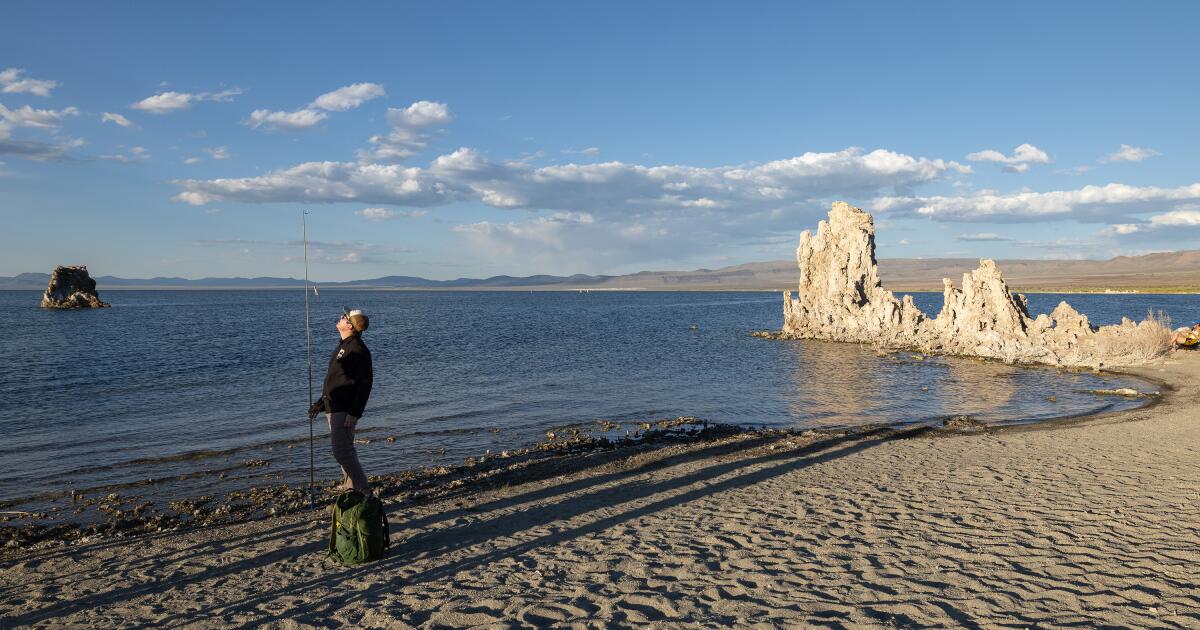LEE VINING, Calif. — At a trailhead surrounded by sagebrush, a naturalist welcomes a group of visitors to Mono Lake beside a sign that reads “Oasis in the Desert.”
Guide Ryan Garrett, his face alight, greets the group of vacationers and entreats them to see the value in the saline lake — it teems with migrating birds, it’s around a million years old, and it’s affected by water use in Southern California more than 300 miles away.
In the early 20th century, Los Angeles built a massive aqueduct to take water from the Owens Valley and soon dried up Owens Lake. Reaching for even more water, L.A. leaders pushed farther and began tapping water from the mountain streams that feed Mono Lake.
Visitors demonstrate how tufa towers are formed by mixing a solution of calcium and carbonate during a tour of Mono Lake.
“Are they still taking water?” one woman asks.
“Yes, they are still diverting water,” Garrett replies.
As they continue, Garrett explains how Mono Lake rapidly declined from the 1940s to the 1980s. They pass interpretive signs showing how much the water level dropped: 7 feet by 1951, 25 feet by 1963.
By 1982, the lake had fallen 45 feet from the natural level local people had once known.
Starved of inflows, the lake lost about half its volume and became twice as salty.
As they walk toward the shore, the group is dwarfed by the lake’s famous craggy formations called tufa nearly 20 feet above them. Garrett stops to describe how the towers of calcium carbonate grew underwater around freshwater springs over thousands of years, then were left exposed as the water dropped.
1/6
A canoe glides between tufa towers at Mono Lake. (Myung J. Chun/Los Angeles Times)
2/6
Ryan Garrett takes a photo of Jerardo and Jeannette Reyes and their children after a walking tour on the shore of Mono Lake. (Ian James/Los Angeles Times)
3/6
A man holds the larva of an alkali fly taken from Mono Lake. (Ian James/Los Angeles Times)
4/6
Ryan Carle stands among tufa towers while walking to the shore of Mono Lake to spot Wilson’s phalaropes. (Ian James/Los Angeles Times)
5/6
Wilson’s phalaropes fly together over Mono Lake, passing a California gull. (Ian James/Los Angeles Times)
6/6
Wilson’s phalaropes take flight on the shore of Mono Lake. (Ian James/Los Angeles Times)
“If we were here in 1941, we would be underwater,” he says.
The free tours, offered twice a day in the summer, take visitors down the South Tufa trail, located in the Mono Basin National Forest Scenic Area.
Some tour leaders work for the state parks; others are guides from the Mono Lake Committee, a nonprofit group. Garrett is the committee’s education director.
At the shore, he squats and dips a clear cup into the salty water.
There are an estimated 4 to 6 trillion brine shrimp in Mono Lake.
“I got one!” he says, passing around the cup, where a tiny brine shrimp is swimming.
The species is found nowhere else in the world. The lake is filled with several trillion of them.
Reaching into the water, he shows his open palm. It’s covered with dark flecks. They’re the pupae of alkali flies, a traditional food source of the Native Kootzaduka’a people. He urges everyone to taste one.
“It tastes salty,” one man says with intrigue.
A California gull runs open-beaked through a cloud of alkali flies at Mono Lake.
These flies and brine shrimp are essential food for migratory birds including eared grebes, Wilson’s phalaropes and California gulls. They need the lake to be at a healthy level and not too saline.
The lake’s threatened health became a rallying cry in the 1980s, when “Save Mono Lake” bumper stickers appeared on cars across California. In 1994, state regulators ordered the L.A. Department of Water and Power to take steps to raise the lake 17 feet by taking less water from the creeks, leaving more to flow into the lake.
Despite that, Garrett says, “Mono Lake is not at the healthy management level.”
He opens his backpack and takes out a collapsible metal pole, extending it 9 feet.
He stands it vertically on the sand to show the lake is still far below the target level agreed on 31 years ago.
“So, the question now becomes, is Mono Lake doomed?” he says. “Is this the highest it can get? No, absolutely not.”
Garrett notes that conservation efforts in L.A. have significantly reduced water use over the last three decades.
Visitors to Mono Lake’s South Tufa area walk along the shore, which was once covered in water as deep as the tallest tufa towers.
The 1994 decision included a backstop: If the lake level doesn’t rise enough, the State Water Resources Control Board is to hold a hearing to determine if the rules need to change — an assessment that both environmental advocates and the DWP’s managers say they hope will happen soon.
“What’s super, super exciting is that hearing is right around the corner,” Garrett says. “So right now is the best time to learn about Mono Lake, because the next great effort to save Mono Lake is about to begin.”
As the tour ends, Jerardo Reyes, a roofing contractor from Rialto, says he hadn’t known about Mono Lake and came away wanting to learn more about the places Southern California gets its water.
He and his wife Jeannette had stopped to see the lake with their four children.
Reyes says he believes that while L.A. needs water, the lake also needs it, and “you’ve got to find a balance.”
“It’s a beautiful lake,” Reyes says. “I hope this lake is here for my kids to see, and my grandkids to see, in the future.”

